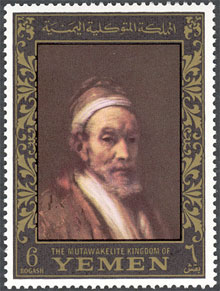
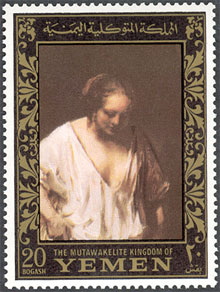
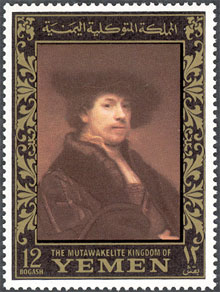
|
FROM DUNES TO IGPC STAMP ISSUING AND PRINTING IN ROMANIA |
In the early 1970's I bought in a philatelic shop a stamp stockbook. This happened in the communist Romania, where I lived then. Like all the shops in Romania, this shop was a stately owned one too.
The reason why I bought the stockbook wasn't necessarily the stockbook itself, even if it was of an acceptable quality, but a Kingdom of Yemen mint set of Rembrandt paintings, perforated and imperforated, that was presented in it. The price of the whole was quite high for my budget, being of about 100 lei, which represented about 8 percent of my salary as a physicist.
The set was issued on 15th of May 1967 and commemorated the AMPHILEX '67 Stamps Exhibition in Amsterdam. At that time I didn't know that the set of 6 stamps was issued in two versions, one with golden and the other one with silver frames, and that each version was accompanied with two miniature sheets, one perforated and the other one imperforated. They are the Michel numbers 278-283 and 284-289, and the Block 37A + B and Block A 37 A + B. I show below three values of this set:
 |
 |
 |
I wondered why the shop sold freely a foreign set of mint stamps, which was totally unusual, so I asked about a more experienced stamp collector. From him I learned that these stamps, like many others, were actually printed in Romania. And indeed, if we compare the results of the printing technologies used for these stamps, we can see some similarities. Please take a look below at some paintings stamps issued also in 1967, but by the Romanian Post. The set of six stamps, of which I display also only three values, was issued on March 30th, 1967. It is the Scott 1907 - 1912. They look quite similar, isn't it?
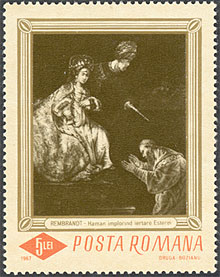 |
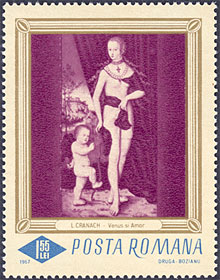 |
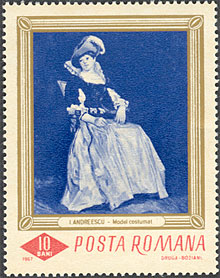 |
Now let's take a look at a set issued by Fujeira on 15th of November 1970, Michel 559 - 573. The date is not mentioned in Michel but we can read it on the stamp below (usually these CTO's are all "cancelled" first day). Just to notice that Michel is the only world catalogue that lists and values the Dunes. Stamps, luridly illustrated and irrelevant to the actual emirates they purported to come from became known as 'dunes'. Their proliferation quickly devalued them. Because of this, many popular catalogues do not list them at all.
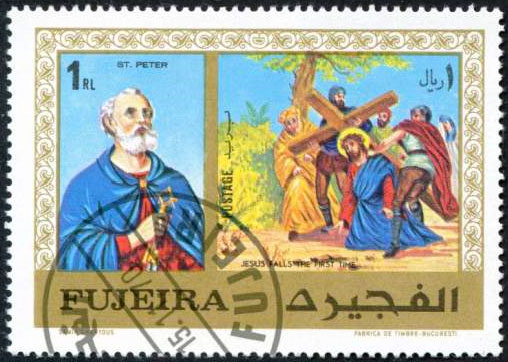
Please read bottom, on the right, the name of the printing office, "Fabrica de timbre Bucuresti", which obviously means The Bucharest Printing Factory. Here is another stamp from the same long set:
This one is interesting for several reasons. Like Rodney from RCSD (thanks for the 3 Fujeira & Chad!) noticed it, it is rather strange that Judas Iscariot appears as a saint. Actually, he was probably mistaken for Saint Jude, who was one of the Twelve Apostles of Jesus. Of course we cannot necessarily expect from the designer, Mr. Samir Ghantous (a Lebanese artist?), to be aware of such subtle differences. If we compare now this set with one issued by the Romanian post (even if it isn't necessary anymore, because the printing office is specified on the stamp itself), we see again some similarities.
Above I show the bottom half of the MS Balcanfila III Stamp Exhibition, Bucharest, June 27-July 2, issued on May 25th, 1971, Scott 2247 a-f. The printing press was obviously replaced by a more modern one since 1967, when there were printed much less colorful stamps. Fortunately, the colors of the Romanian MS are less strident than those of their Fujeira counterparts.
Here another MS, by the same designer, and printed by the same Fabrica de timbre Bucuresti, that was issued on 15th May 1972 in the name of Chad. This Scouts MS is listed by Scott as C120. It was probably issued by the very contoversial Middle East Stamp Company (thanks John Lowe, USA). In Michel, that lists almost everything, this MS appears as Block 39A. After Michel the date of issue was the same 15th May 1972.
Just to mention that President Tombalbaye, who largely decided who gets the contacts for stamps, is known for having arrested some major political companions for allegedly using witchcraft to overthrow him. The name of the capital, Fort-Lamy, that appears on the cancellation, was changed by Tombalbaye on April 6, 1973 to N'Djamena, and he changed his own name to Ngarta, both actions under the guise of so-called "authenticité" movement.
What we can say today is that the communist Romanian government largely contributed to the spreading of Dunes and other dubious stamps, which was the beginning of the massive perverting of stamp issuing, that undermined the trust of many collectors in philately. The Romanian communist government did it with the help of some unscrupulous Western stamps dealers, helped at their turn by some catalogue editors, who, by listing these "stamps" in their catalogues, contributed to the general confusion among the philatelists worldwide. For the Romanian government this was still another source of clean foreign currency, that it could use in its subversive policies against the same West from which it took the money, and also for enhancing the luxurious style of life of its own nomenclatura.
Please see below an exemple of another Fujeira S/S, Michel Block 84A, Horses Heads, issued (after Michel 2013) on the 15th of October, 1971.
What is much more interesting is the name of the designer, the Romanian artist Aida Tasgian Constantinescu, who is well well known for having designed many postal stamps issued by Romanian Post.
The situation hasn't necessarily improved much since, this because in the meantime the Romanian Post became a so-called Client Nation of the Inter-Governmental Philatelic Corporation (IGPC). Like so many of IGPC clients, Romania issues a big number of sets and MS, year after year, sometimes approaching some records set by excessive stamp issuing countries like Liberia, Gambia or Grenada-Grenadines. In an European comparison Romania is also placed in a top position. After the official WNS site, managed by the UPU, only in the year 2007 Romania issued a total number of 105 stamps, which is a lot when compared with the production of much bigger countries, like Ukraine: 93, Spain: 86, Russia: 57 or Poland: 47.
We can confidently assert that the "golden old times" of the Romanian stamps overproduction are back again. This was made possible by the new Heidelberg press, bought in 2004 by the Tipografia Posta Româna, the former Fabrica de timbre Bucuresti. It is a computer assisted equipment that reduced the time of order processing, when compared with the former about 30 years old press, from a a few days to a few hours. The production line, the most efficient in the Central Europe, reduced the production costs three times, increasing also three times the printing speed, even if the number of used colors increased from four to six. Source: the statement of the former Minister of Communications and IT, Mr. Dan Nica, Curierul National, 7th of July 2004.
Update 2018. The Scott catalog / Linns editors compiled the yearly count of stamp issues and their costs for almost all countries. In the table below we reproduce these figures for Romania and The Netherlands, as follows:
We can infer that the quantity of stamps issued by Romanian Postal Administration (PA) increased by almost a half, and that their face value almost tripled since 2011. For comparison purposes we display the same data for The Netherlands PA (a country with about the same population as Romania), that issued in 2016 five times less stamps than the Romanian one, and with less than a half of the total face value. The difference is amazing, considering that The Netherlands have a much higher living standard than Romania has.
The large number of stamps can be possibly explained by the fact that Romania is a customer of IGPC, an agency that was or is issuing postage stamps for countries such as Gabon and Sierra Leone, known for the large number of stamps they throw on the market, and which are classified by the International Federation of Philately (FIP) in the category of abusive stamp issues.
| Published:
04/08/2009. Revised:08/28/2023. Copyright © 2009 - 2023 by Victor Manta, Switzerland. All rights reserved worldwide. |